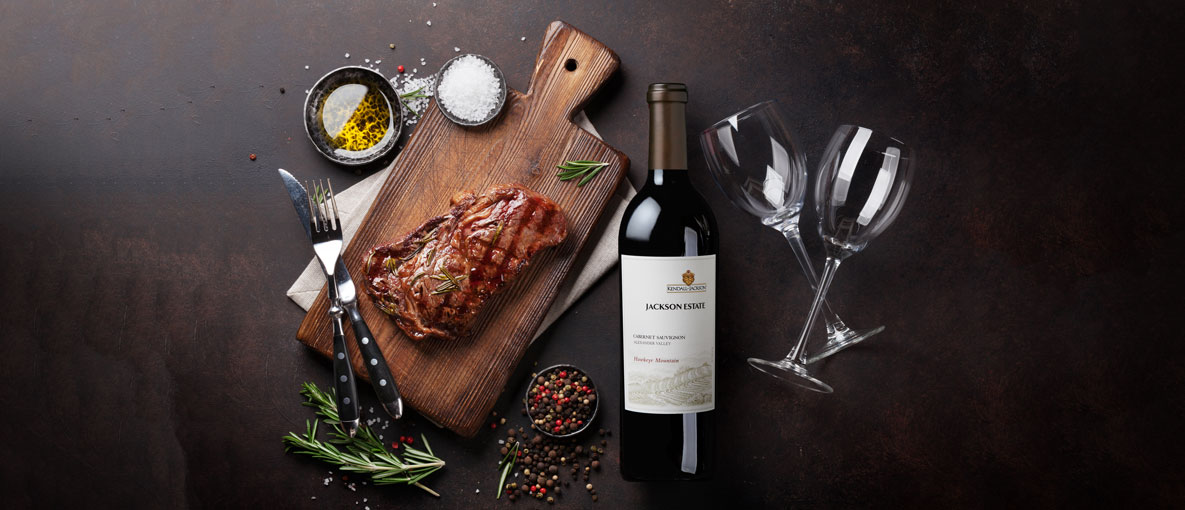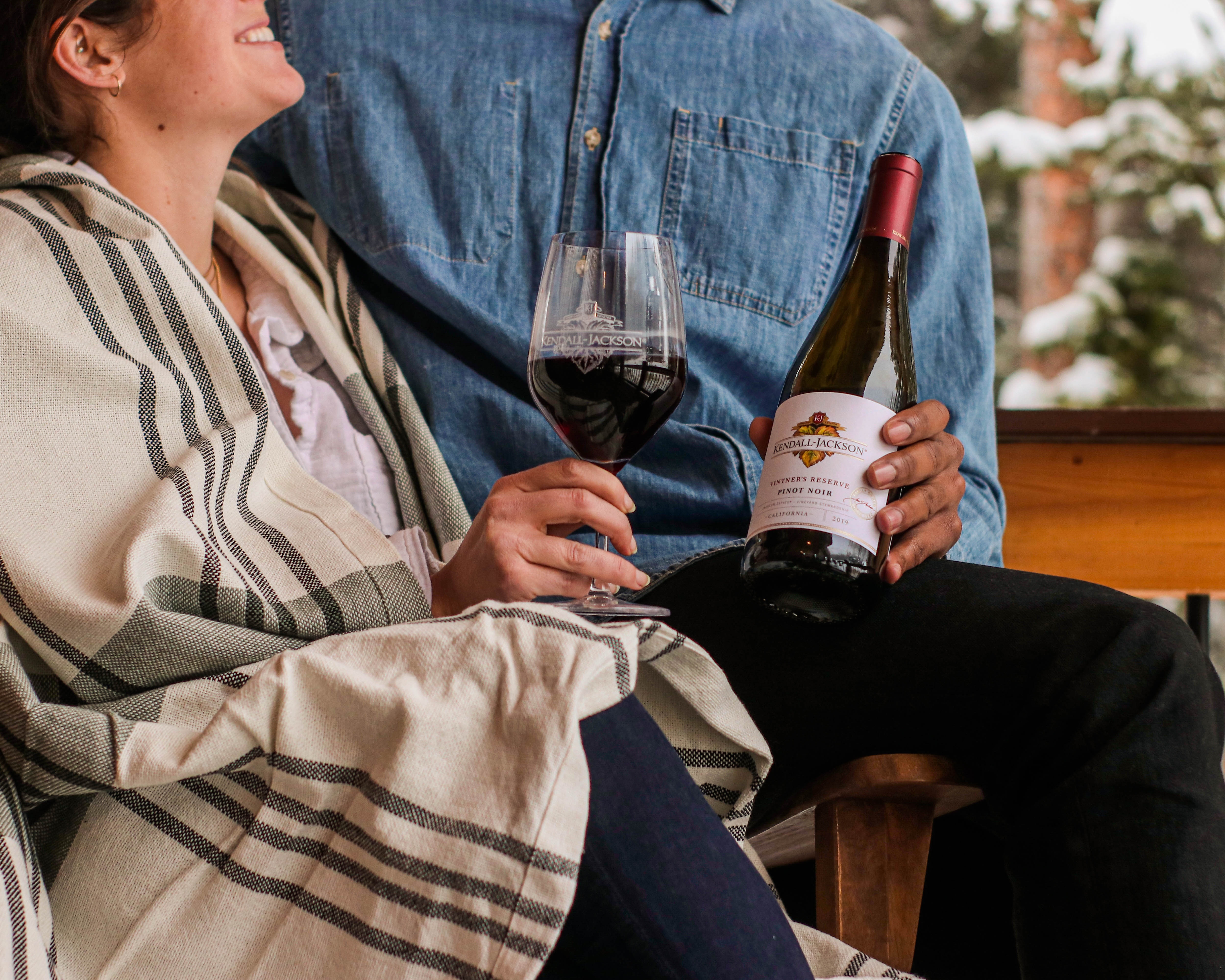Pairing Fall Fruits and Vegetables with Wine
Whether the tree leaves around you have begun to change colors and drop or you still are wishing that they soon would, it’s a good time to start thinking about pairing fall fruits and vegetables with wine.
In Sonoma, the traditional series of Kendall-Jackson Farm-to-Table dinners comes to an end in a few weeks. Just before it does, the second Annual Harvest Celebration will showcase the tantalizing teamwork of the Kendall-Jackson Wine Estate and Gardens culinary team and gardeners. You can sit back and enjoy the “fruits” of their labors with a few glasses of carefully picked fall wines, but you also can learn from the team firsthand, too. Truffle foraging, anyone?
If you can’t make it to Sonoma to celebrate the bounty of the harvest season, solace is now available in a beautiful book, Season: A Year of Wine Country Food, Farming, Family, and Friends. It offers an insiders’ view of the Kendall-Jackson farm-to-fork philosophy between the produce of the K-J Culinary Gardens, headed by master culinary gardener Tucker “Farmer T” Taylor, and the kitchen creativity of Tracey Shepos Cenami.
One of my favorite bits of the book is in the introduction, where the chefs explain that most of their colleagues make their food then have the sommeliers pair wines with those foods. However, the K-J wine pairing philosophy is to start with the wine then “create food to pair with the wine.” The Season cookbook is an inspirational resource for your fall fruit and wine and fall vegetable and wine pairings, as well as those for the seasons to follow.
Why Pair Fall Produce with Wine?
One of the most exciting things about pairing fall’s seasonal produce with wine is that the spectrum of wine possibilities widens. Sure, you can have a chunky red with a summer barbecue, but big red wines don’t work so well with most other summer dishes.
Fall is the optimal shoulder season to approach just about every wine style. Fall produce pairings combine the brightness and lightness of summer wines with the heartiness of winter wines. This is particularly true early in the season when both late summer and early-to-mid fall produce are flourishing. (The spring shoulder season leans from the mid-weight to lighter side of the wine spectrum.) Fall’s bountiful array of produce provides the perfect moment for wine pairings with vegetarian and vegan dishes.
Additionally, autumn fruits and vegetables work well with a broader selection of wines because with fall’s changes in weather, we employ many more cooking techniques. Fresh, tossed salads and outdoor grilled goodness fade into the background as we return to the modern day “hearth”. Between the stove and the oven, we use many more techniques, from simmering, sautéeing and frying to baking and roasting.
Expert Tips for Pairing Wine with Fall Fruits and Vegetables
Let's look at some key tips for elevating your fall wine and food pairings. Understanding these fundamentals will help you confidently experiment with different combinations and create unforgettable dining experiences.
Tricky Pairings
Preparing autumn vegetables and fruits means considering a few factors to insure successful wine pairings. Pairing fall fruits with wine and fall vegetables with wine is slightly less tricky than the wine pairings for summer fruits and vegetables. In part that is because of the produce is cooked more often, as mentioned above. The other reason is that the fall Farmers’ Market selections are just naturally more wine friendly. Just about the only taste to watch for is bitterness that can stem from less-than-well-cooked garlic and any vegetable considered cruciferous.
Food Colors
Generally, lighter colored foods match better with lighter colored fall produce. Darker hues and colors of foods help you work up the wine color spectrum. That is to say that cauliflower and Napa cabbage generally work best with lighter wines – not just white wines but lighter-colored white wines, too. Following this principle, winter squash and pumpkin can move into darker-hued whites. Graduate into reds with beets, figs and pomegranates, amongst others.
Cooking Temperatures
Considering how seasonal fruits and vegetables are prepared will help in pairing them with wines. Lower heat preparations often work well with mid-weight wines. When you turn up the temperatures to roast or grill a food, for example, heavier wines start to match nicely, too.
Fall vegetable and fruit preparations can also help you judge just how much new, toasty and creamy oak character your food can handle. The lower the cooking temperature, the less likely the veg or fruit can handle the flavor imparted by new oak use on a wine. Higher heat techniques create more caramelization of the natural sugars in fall fruits and vegetables. Higher cooking temperatures develop more concentrated flavors. Food cooked this way can face a little more of new oak’s mocha, coffee or caramel flavors in the glass.
Accompaniments
When fall produce is served more or less on its own, the wine pairing process is simpler. When veggies and fruits are accompanied by foods that definitively make their own mark, the ensemble must be considered. Steamed Brussels sprouts with salt, pepper and cultured butter? I might opt for a Sauvignon Blanc, between the cooking temperature and the leafy, garden-tinged notes of the vegetable. Roasted Brussels sprouts with bacon? I am more likely to reach for a Merlot given the higher temperature cooking method and the savory, fatty pork addition.
Major Fall Vegetable and Fruit Produce Groups
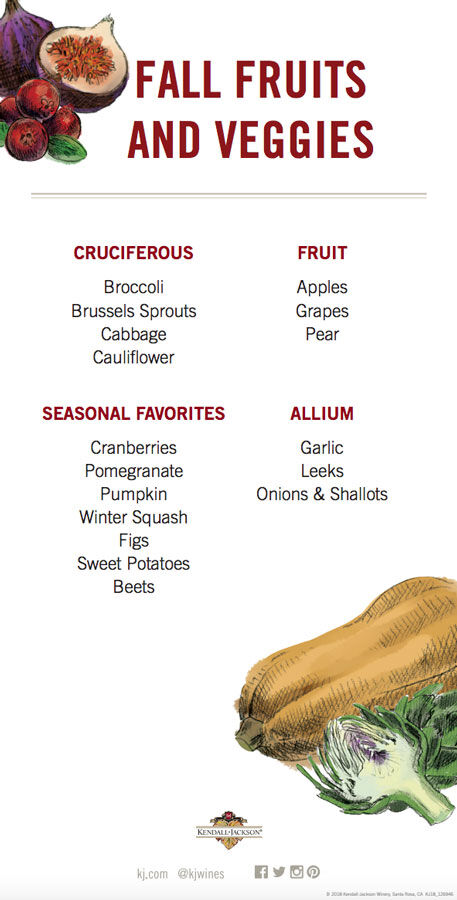
Allium
Preparing fall produce usually means combining several fruits or vegetables. The most obvious accompaniments are members of the allium genus, which includes:
- onions
- shallots
- leeks
- garlic
The allium group is often thought about in terms of contributing savoriness. Its members are often used with other veggies.
Yet, a lot of produce we think of as vegetables – because we use them in savory preparations – are actually fruits. (Botanically, a fruit bears seeds. So, pumpkins and winter squash – for example – are fall fruits rather than fall vegetables.)
It turns out that the allium genus also contributes sweetness. Yellow onions and leeks are pretty clearly sweet, but garlic can be, too. Just cook garlic longer and at lower temperatures to release its sweeter side.
In sum, the allium family works meshes well with both fall vegetables and fall fruits. Unless served raw as an accompaniment, the allium family generally isn’t too demanding on fall wine pairings.
Cruciferous
The next member of fall seasonal produce is the cruciferous family, which includes popular vegetables such as:
- broccoli
- brussels sprouts
- cabbage
- cauliflower
For most folks, the cruciferous crew is the least favorite of the veggie food families.
There are two reasons for this:
1) They smell sulphury. For this reason, cruciferous family members are often white wine vegetables, especially when served on their own. White wines often have a vague scent of struck match when first opened that aligns well with this sector of the vegetable world.
2) They are hard to cook properly. This is why this group that is chock-full-o’goodness for our bodies often gets a lift from other foods. We know we need to eat them, so we make it easier on ourselves! Beware those accompaniments when considering their possible wine partners.
The cruciferous club also tends to taste very “green”, as in leafy or grassy. Because of this, it is worth thinking about pairing them with wines that have that same herbal lift. The grape varieties best known for this inherent characteristic are Sauvignon Blanc, Cabernet Sauvignon and Cabernet Franc. Sometimes Merlot has a tinge of it, too.
Why? Sauvignon Blanc and Cabernet Franc and the “parents” of Cabernet Sauvignon, and one of Merlot’s parents is Cabernet Franc. As they say, it’s all in the family!
Fruits and Seasonal Favorites
Generous in natural sugars and packed with flavor, fruits pairings with wine are supremely easy and seasonal favorites make dynamite pairings with wine. After all, wine is made from fruit!
Because of the ample flavors here, both the fruits and seasonal favorites categories below are often combined with other dynamically flavored foods. This works in lockstep with darker hued and darker colored wines. Favor the focal food of the dish and its cooking method for your wine pairing guidance.
Favorite Wine Pairings with Fall Fruits and Vegetables
Sauvignon Blanc
- Cooking: Pale in color, Sauvignon Blanc works best with foods that see less cooking time at lower heat.
- Produce: This grape’s herbal tones mesh well with green apple, artichoke and Brussels sprouts. Cruciferous vegetable wine pairings rock with Sauvignon Blanc.
- Serving suggestion: Chicken Breasts with Herb Basting Sauce
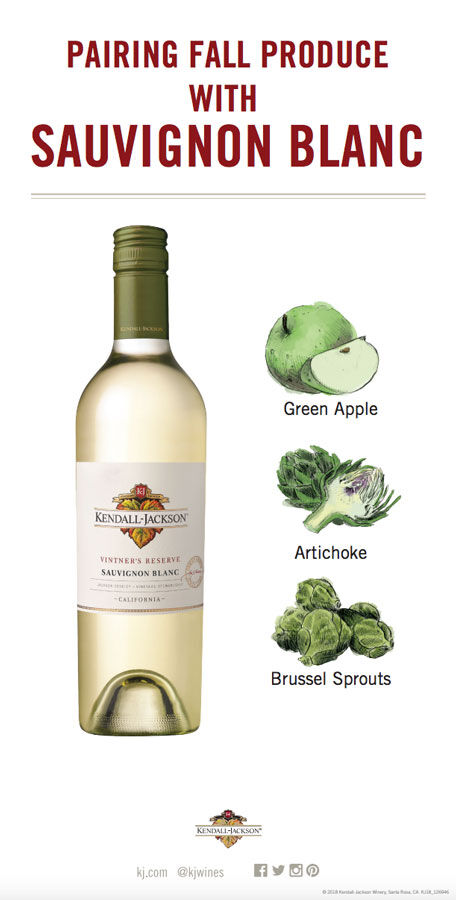
Rosé
- Cooking: Pale to dark in color, rosé is the ultimate crossover. It generally is made with red grapes but drinks chilled like a white. For paler rosés, stick to lighter foods. Ratchet up the spectrum to more deeply colored rosés for pairings with weightier foods. Rosé is also an exceptional wine pairing with fruit and cheese.
- Produce: Rosé is often a blend, so it is an all around winner. Where it’s a cruciferous like cauliflower or a starchy sweet potato, rosé can handle it. The same with garlic, whether it is cooked quickly to show a more biting expression or slow-cooked to make it sweeter.
- Serving suggestion: Fried Cauliflower with Whipped Feta
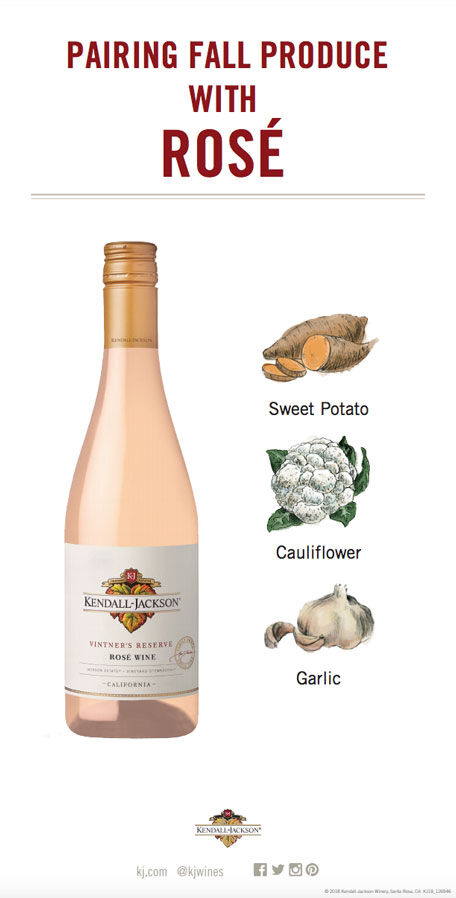
Chardonnay
- Cooking: Most Chardonnays boast a deep lemon yellow color that suggest the wine has been made and/or aged in oak. These Chardonnays easily take on heartier fall produce that has seen hotter and often longer cooking methods. For pale, unoaked or very gently oaked wines, the same foods often work well when cooked at the cooler end of the temperature scale.
- Produce: Chardonnay’s generally rounder palate feel gives it good pair-ability with the ample flavors of pear, butternut squash and potatoes.
- Serving suggestion: Pumpkin, Ricotta & Arugula Bruschetta
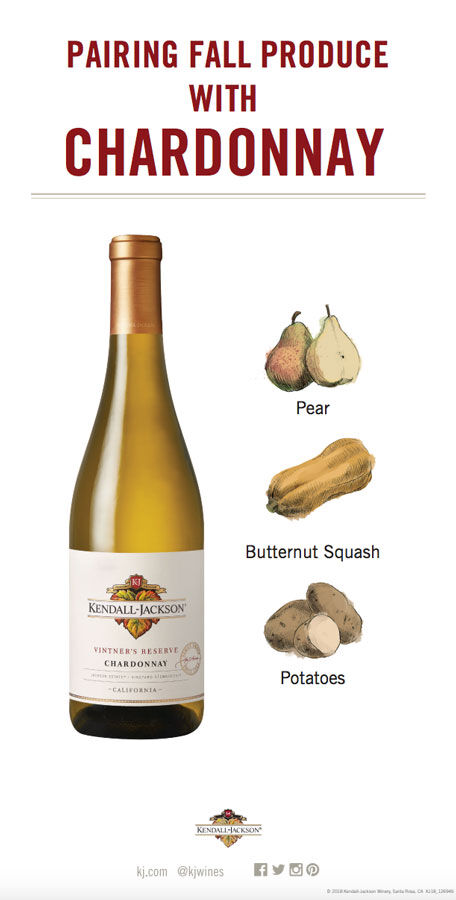
Pinot Noir
- Cooking: Pinot Noir is generally the lightest of the best-known red wines, so it works best with mid-weight fall fruits and vegetables. However, it can work equally well with veggies and fruits that are cooked on the stove or in the oven.
- Produce: The fleshy “meat” of figs blends well with Pinot Noir’s fruit-driven side while the earthy undertones of the grape blend well with the same in beets and mushrooms.
- Serving suggestion: Wild Mushroom and Herb Chowder
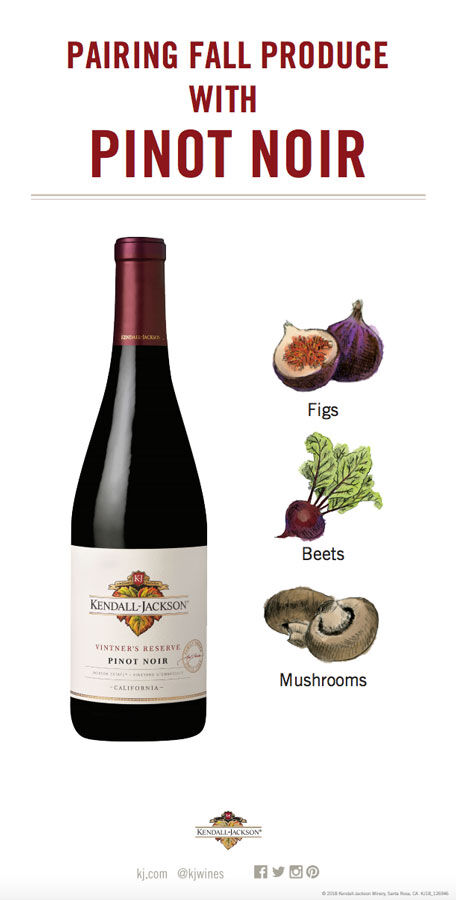
Cabernet Sauvignon
- Cooking: The hefty and powerful palate of Cabernet Sauvignon is typically paired with seared or grilled meats.
- Produce: However, the leafy tones of Cabernet Sauvignon make it excellent for pairing with certain fall cruciferous vegetables, especially broccoli. It can also pair exceptionally well with sweet-tart fruits like cranberries and persimmons because the wine’s upfront dark fruits (which give a perception of sweetness) are nicely contrasted by the wine’s double-punch of firm tannins and brightness acidity (which together create a refreshing quality akin to tartness.)
- Serving suggestion: Vegetable Cheddar Soup Bread Bowls (I absolutely love this vegetarian recipe with red wine because it is a perfect example of not needing meat, game or poultry at the table to enjoy a hearty red.)
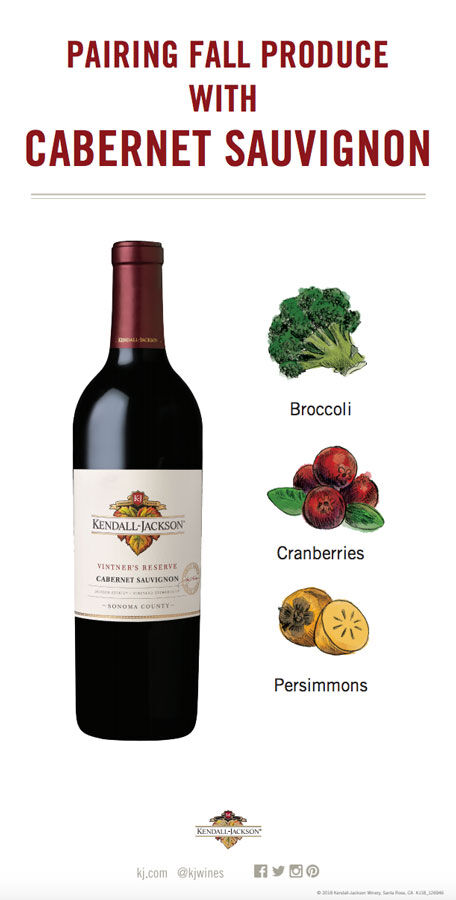
How to Host Fall Wine Tasting Events
Fall is the perfect season to host intimate gatherings centered around wine tasting. Whether you're planning a casual get-together with friends or a more formal event, here are some tips to help you create a memorable fall wine tasting experience:
Creating a Fall Wine Tasting Menu
Start by selecting a variety of wines that showcase the flavors and characteristics of the season. Consider including wines that had been mentioned previously in the blog, such as Chardonnay, Sauvignon Blanc, Rosé, Pinot Noir, and Cabernet Sauvignon. Craft a tasting menu that includes a mix of these wines, allowing guests to explore different styles and flavors. But always ensure wines are served at the appropriate temperature to showcase their flavors best. White wines are typically served chilled, while red wines are served at room temperature or slightly cool.
Cheese and Charcuterie Boards with Fall Produce
Create complementary pairings by matching the flavors and textures of cheeses and charcuterie with the wines you've selected. For example:
- Soft Cheeses: Pair with light-bodied wines such as Sauvignon Blanc or Pinot Noir.
- Hard Cheeses: Match with fuller-bodied wines like Cabernet Sauvignon or Merlot.
- Spicy Charcuterie: Balance with bold wines such as Zinfandel or Syrah.
Incorporate fall fruits like figs, pears, or cranberries into your cheese boards to add seasonal flair. Want to learn more about creating the best charcuterie boards? Check out our blog here on how to make a cheese board.
Cozy Atmosphere and Seasonal Decorations
Enhance the ambiance of your wine tasting event with a cozy and inviting atmosphere:
- Decorations: Use autumn-inspired decor such as pumpkins, fall leaves, and rustic table settings. Candles or string lights can add warmth to your space.
- Music: Choose background music that complements the mood, such as acoustic or jazz tunes.
By paying attention to these details—you'll create an enjoyable and memorable fall wine tasting event for your guests.
Create Memorable Fall Moments with Kendall-Jackson Wines
Fall wines segue perfectly with seasonal produce in the Kendall-Jackson farm-to-table philosophy. As is written in the Season cookbook, “Fall is the season of giving thanks for the gifts of the land, and there’s no better way to do that than sharing the bounty with the people you care about.” I hope you enjoy this primer for sharing and pairing fall fruits and vegetables with your favorite K-J wines!
Curious about expanding your knowledge of wine and perfecting your skills as a wine host? Learn more about creating unforgettable wine experiences with Kendall-Jackson wines at our Entertaining page, where you'll find everything you need to host memorable occasions.
Christy Canterbury is a Master of Wine, journalist, speaker and judge based in New York City. In 2014, she was short-listed for the Roederer Online Wine Communicator of the Year Award. Her work has been published in Decanter, Wine Enthusiast, Edible Green Mountains, Wine Searcher, Food Arts, Snooth, Beverage Media, TimAtkin.com, Civiltà del Bere, Wine Business Monthly, TASTED, Selectus Wines and in other outlets.
Frequently Asked Questions
1. What are some general principles to keep in mind when pairing wine with fall produce?
When pairing wine with fall produce, consider factors like the intensity of flavors, cooking methods, and the natural sweetness or acidity of the ingredients. Balance these elements with the characteristics of the wine to create harmonious pairings.
2. How can I enhance the flavors of fall dishes with the right wine selection?
Choose wines that either complement or contrast with the flavors of fall dishes. For example, wines with higher acidity can cut through rich, savory flavors, while wines with fruity notes can enhance the sweetness of seasonal fruits.
3. What are some tips for pairing wine with fall salads and appetizers?
Pair crisp, acidic wines like Sauvignon Blanc or sparkling wines with fall salads to complement their freshness. For appetizers, consider lighter wines that won't overwhelm delicate flavors, such as Pinot Grigio or a dry Rosé.
4. What should I consider when pairing wine with fall soups and stews?
Choose wines that match the intensity and richness of fall soups and stews. Bold red wines like Merlot or Malbec pair well with hearty beef stews, while lighter reds like Pinot Noir complement lighter soups like mushroom or butternut squash.
5. Can I incorporate wines into fall-themed desserts?
Absolutely! Select dessert wines like Port or late-harvest Riesling to complement the sweetness of fall desserts such as apple pie, pumpkin cheesecake, or pear tart. The wine's richness and sweetness can enhance the flavors of the dessert.






